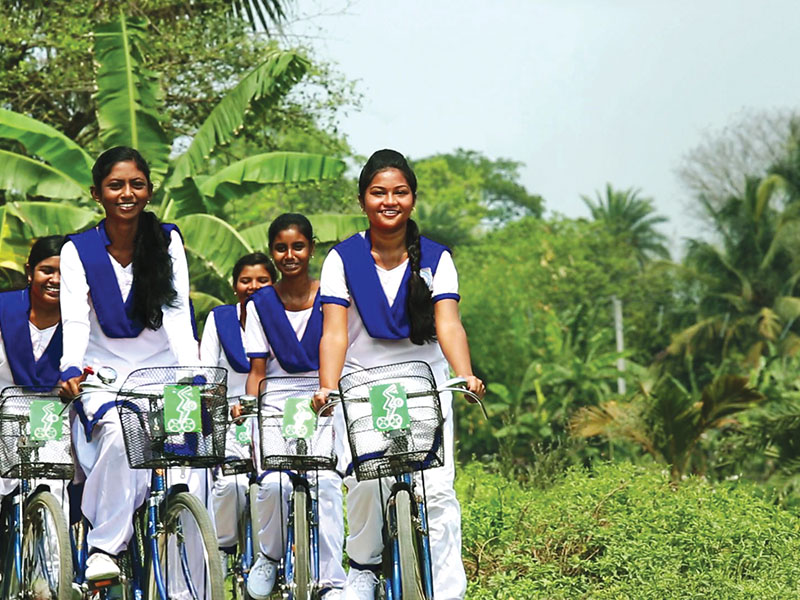Baishali Mukherjee (Kolkata)

Sabuj Sathi beneficiaries
Ahead of the forthcoming lok Sabha polls scheduled for April-May, Chandrima Bhattacharya, minister of state (independent charge) for finance, tabled a Rs.3.66 lakh crore budget on February 8, announcing a slew of social welfare policies including sops for women and children.
While continuing with existing welfare schemes such as the Kanya Shree and Sabuj Sathi schemes for girl children, the Trinamool Congress government — now in its third consecutive term in office — introduced a gender and child focused budget to uplift women and promote holistic development of children with a sizeable allocation of Rs.96,271 crore. The budget also allocates Rs.900 crore to class XI students to purchase tablets or smartphones under the Taruner Swapno (youth’s dream) scheme introduced in 2022.
Since 2013 — two years after the Mamata Banerjee-led Trinamool Congress (TMC) routed the Left Front government in the assembly elections of 2011 — the chief minister has been making commendable efforts to improve girl-child education in West Bengal’s 92,000 government schools. She has announced an array of schemes including the popular Kanya Shree and Sabuj Sathi programmes.
Launched in 2013, Kanya Shree offers an annual Rs.500 scholarship for girls to continue education; one-time grant of Rs.25,000 for girl children from BPL (below poverty line) homes who clear the class X board exam; Rs.30,000 after clearing the class XII board exam, and scholarships for girls pursuing post-graduate studies in science and non-science streams. Under the Sabuj Sathi scheme, launched in 2015, 2.5 million bicycles have been distributed to girl students in classes IX-XII. However despite these incentives, the literacy rate of women in the state is 59.73 percent cf. 79.89 percent for men.
In this context, it is also pertinent to note the one-time Rs.30,000 grant awarded to girls clearing the class XII board exam is largely used to pay for marriage expenses. According to the Sample Registration System (SRS)-Statistical Report 2020, Bengal’s percentage of women marrying below 18 years is 4.7 percent and between 18-20 years of age 50.2 percent, against the national average of 1.9 percent and 26.7 percent respectively.
Moreover, according to the latest available Periodic Labour Force Survey (2018-19), women’s unemployment in Bengal has risen from 2.5 percent in 2011 to 4.4 percent in 2019. Yet despite incentives for girl children, against 61 percent of males, only 15 percent of females are in the labour force. Moreover against the national trend of a larger proportion of women employed in education, in West Bengal, women constitute only 14 percent of teachers. All this has raised questions about the efficacy of girls education incentives doled out by the TMC government.
Critics of West Bengal’s feisty woman chief minister highlight that with Banerjee paying excessive attention to the advancement and emancipation of girl children, a large number of boys are dropping out of the school system. A survey released in July 2021 by the Unified District Information System for Education Plus (UDISE+) has highlighted that while the dropout rate of girls is 13.6 percent, for boys it is 14.1 percent. Unsurprisingly, the number of registered unemployed youth in Bengal is a massive at 7.6 million.
Although Banerjee’s critics blame the TMC government for high unemployment, Bengal’s job market started deteriorating during 34 years of uninterrupted rule (1977-2011) of the CPM (Communist Party of India-Marxist)-led Left Front government when labour militancy and violence was officially encouraged and there was a continuous flight of capital and industry from the state. The damage suffered by West Bengal’s economy by capital flight during the Left Front government rule was huge. The value of industrial output of West Bengal as a share of the total industrial output of India plunged from 9.8 percent in 1980-81 to 5 percent in 1997.
However, high hopes of an industrial revival after the Mamata Banerjee-led TMC routed the CPM-led Left Front parties in the assembly election of 2011, have been belied. Instead of rejecting agitational Marxist politics, Banerjee and TMC party cadres have continued the state’s tradition of confrontational anti-industry policies which have depressed business confidence and failed to attract investment necessary for generating employment. As a result, overt and disguised unemployment is rife in the state which until the mid-1960s was the industry and commerce epicentre of India.
West Bengal’s 2024-25 budget packed with welfare schemes has ballooned the state’s fiscal deficit to Rs.68,250 crore, nearly 37 percent higher than in 2023-24, stoking fear of inflation.
Psephologists in Kolkata agree that Banerjee’s welfare schemes, especially for education, played a major role in TMC bucking anti-incumbency and winning three consecutive assembly elections. But this time around, major scandals have surfaced in the education sector, especially several teacher recruitment scams forcing the Calcutta high court to freeze recruitment. Moreover, recent incidents of violence perpetrated by TMC cadres against women of Sandeshkhali village in the North 24-Parganas has dented Banerjee’s pro-women feminist image.
In General Election 2019, BJP bagged 18 of Bengal’s 42 Lok Sabha seats — up from a mere 2 in 2014. This time with prime minister Narendra Modi having set the target of BJP winning all 42 Lok Sabha seats in the General Election 2024, Mamata Banerjee has a real fight on her hands.
Also read: West Bengal: Reckless Neglect



























